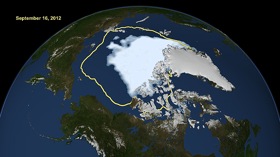Climate expert: Record loss of arctic ice could impact Wisconsin
Ice covering the Arctic Ocean melted to the smallest areal extent ever recorded this year, falling to 1.3 million square miles at its lowest point on Sept. 16, according to the National Snow and Ice Data Center. That’s less than half of the normal area covered by ice at summer’s end.

An image of the Arctic sea ice on September 16, 2012, the day that the National Snow and Ice Data Center identified to be the minimum reached in 2012. The yellow outline shows the average sea ice minimum from 1979 through 2010.
Photo: NASA
“This is not only a record low, but it easily broke the previous record, set in 2007, by an area larger than Texas,” says Steve Vavrus, a senior scientist in the Nelson Institute Center for Climatic Research at the University of Wisconsin–Madison. “Each of the last six years has produced late-summer ice coverage far below all previous summers since accurate satellite measurements began in 1979.”
Vavrus, an expert on the arctic climate, says the dramatic melting trend is due to rising concentrations of greenhouse gases in the atmosphere warming the planet. He says natural variability may have accelerated the loss of ice in recent years, and he adds that the far north has physical characteristics that make it more sensitive to warming than other parts of the globe.
For one, he explains, snow and ice that normally cover the region reflect most incoming solar radiation back to space, but increased melting exposes land or ocean water that absorb more solar energy and accelerate any warming trend.
In addition, the lowest layer of the atmosphere in the Arctic is thin and prone to temperature inversions that hold warmer air near the ground, promoting even more melting as the region warms.
Vavrus says the Arctic is likely to continue to see pronounced downward trends in sea ice, snow cover, glacier extent, and permafrost. He says that will have major impacts on both natural ecosystems and human communities in the northernmost latitudes.
But the impacts of a warming Arctic could also be felt far beyond the region, including in the Midwest, according to research conducted by Vavrus and his colleague Jennifer Francis at Rutgers University published in the journal Geophysical Research Letters last spring.
“We believe that the winds aloft at the level of the jet stream will weaken and lead to slower-moving and ‘wavier’ atmospheric circulation patterns,” he explains. “Such a change would favor more extreme weather events in middle latitudes, such as heat waves, droughts, floods, and — ironically — cold snaps.”
Vavrus sees a connection between the record Arctic melting and recent unusual weather across the country.
“This year alone has produced dramatic examples of societally relevant extremes right here in Wisconsin: a very mild winter, an absurdly warm March followed by a killing frost, and record dry and hot weather during the summer,” he says.
In addition, Vavrus says the accelerating Arctic warming trend raises a number of challenging social and economic issues.
“The sea ice is retreating faster than climate models predicted,” he says. “There is suddenly tremendous interest in commercial shipping, energy exploration, international territorial claims and tourism due to the increasingly accessible Arctic Ocean. At the same time, serious questions loom about the impact the rapid changes are having on local ecosystems and native peoples accustomed to a colder and more predictable climate.”
While the far north is warming at a faster rate than anywhere else, Vavrus says it offers a preview of the kinds of challenges other regions will likely face as the planet continues to warm.
“In the Arctic, the future is now,” he says.




